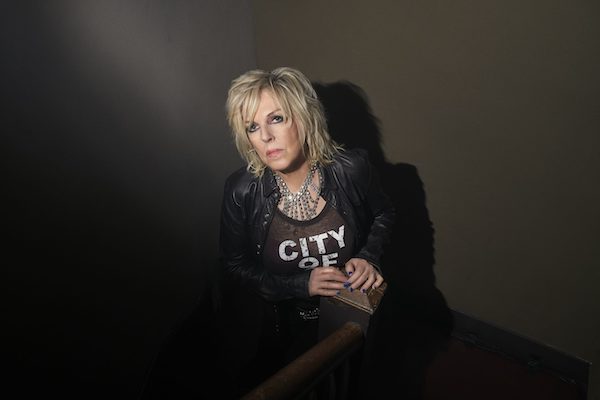Dec 9, 2025 12:28 PM
In Memoriam: Gordon Goodwin, 1954–2025
Gordon Goodwin, an award-winning saxophonist, pianist, bandleader, composer and arranger, died Dec. 8 in Los Angeles.…

Lucinda Williams latest effort, Good Souls Better Angels, was issued in April.
(Photo: Danny Clinch)Lucinda Williams, Good Souls Better Angels (Thirty Tigers/Highway 20 H2006; 59:46 ****)
Early concerts and dawn-of-her-career albums in 1979 and ‘80 portrayed Williams as a torchbearer for blues music. Ever since, she’s retained Delta blues imagery as part of her palette, even while securing cult-figure stature in alt-country and rock. Now, more than 10 albums later, Williams fully reveals herself to be a resourceful, iconoclastic blues singer, projecting the craggy shadings and astringent, blurred tones of her natural voice on new material written with her husband, Tom Overby. Williams knows the human condition can be dark; unnerving, edgy songs concern domestic abuse (“Wakin’ Up,” evoking a Patti Smith-like apocalypticism), the 45th president (“Man Without A Soul”), depression (“Big Black Train”), the Old Testament (“Pray The Devil Back To Hell”) and the fall of man (“Big Rotator,” somewhat reminiscent of “John The Revelator”). She’s up for raw, tough-minded confrontation, emboldened by hope, fortitude and a moral code.
Andrew Alli, Hard Workin’ Man (EllerSoul 20201; 38:30 ***1/2)
Alli’s first full-length shows his main strength to be an ability to captivate with a harmonica sound that nods to his idols—Big Walter Horton, Little Walter and George “Harmonica” Smith—without impeding the development of his own style. On originals and numbers associated with those three historical figures, the 31-year-old takes his time and hits the right notes. A regular in Richmond, Virginia-clubs, Alli also possesses a skillful intensity of appeal and convincingness as a singer. In the band, California guitarist Jon Atkinson consistently renovates tradition to suit modern expectations.
Avey Grouws Band, The Devil May Care (Self Release; 35:35 ***1/2)
Semi-finalists at the 2020 International Blues Competition, Iowa’s Avey Grouws Band channels its pent-up enthusiasm and not slight musical ability toward an individuated brand of blues-rock that recommends its first album. Jeni Grouws’ limber voice rings with conviction, ratcheting up intensity on original tunes sans artifice. She shares the dominant aural presence with far-above-average guitarist Chris Avey, who ranges from Robert Crayish spikiness to jazzy lyricism. Standouts “The Devil May Care” and “Dirty Little Secret” explore an emotional world where lust rivals mental-physical stability. Of eight more, just “Long Road” disappoints for its fake-profound rock gestures.
Ryan Perry, High Risk, Low Reward (Ruf 1278; 52:39 ***1/2)
Best known as a member of the Homemade Jamz Blues Band, Mississippian Perry solidifies his position at the vanguard of blues millennials with this recorded-in-Berlin debut. His way-down-low voice and soul-probing guitar work, forcibly agitated on occasion, points to someone open to understanding the bewildering vicissitudes of romance. His gift for casting moods, both self-assured and defensive, through songwriting is evidenced on most of his eight compositions. A Gil Scott-Heron-type compassion informs his vocal on “A Heart I Didn’t Break.”
Watermelon Slim, Traveling Man (NorthernBlues 0066; 65:20/33:03 ***1/2)
Slim—celebrated the past 15 or so years after a few decades of obscurity—holds the attention of Oklahoma clubgoers during a pair of 2016 solo shows. His singing in a weathered, starkly affecting voice and his careful playing of harmonica and electric slide guitar bring a certain charisma to the no-frills country-blues he’s penned about mortality, retirement and the road. He’s at his most poignant communicating the feelings evoked by his reworkings of Mississippi Fred McDowell’s “61 Highway” and a traditional work song favored by McDowell, “John Henry.” It is serious fealty: as a soldier in Vietnam, Slim kept sane learning to play guitar from McDowell records.
Casey Hensley, Good As Gone (Vizztone 02; 34:34 **)
Following the well-thumped path opened up by forebears like Janis Joplin and Koko Taylor, Hensley renders the originals on her initial studio album with a four-alarm blaze of a voice. But the Californian’s hyper-enthusiasm is mired in mannerisms. Real interaction between Hensley, in her mid-twenties, and the truth of the song being sung takes a back seat to theatricality. A supercharged band with guitarist Laura Chavez helps her turn each tune into an aria. DB
This story originally was published in the July 2020 issue of DownBeat. Subscribe here.

Goodwin was one of the most acclaimed, successful and influential jazz musicians of his generation.
Dec 9, 2025 12:28 PM
Gordon Goodwin, an award-winning saxophonist, pianist, bandleader, composer and arranger, died Dec. 8 in Los Angeles.…

Nov 13, 2025 10:00 AM
For results of DownBeat’s 90th Annual Readers Poll, complete with feature articles from our December 2025 issue,…

Flea has returned to his first instrument — the trumpet — and assembled a dream band of jazz musicians to record a new album.
Dec 2, 2025 2:01 AM
After a nearly five-decade career as one of his generation’s defining rock bassists, Flea has returned to his first…

“It’s a pleasure and an honor to interpret the music of Oscar Peterson in his native city,” said Jim Doxas in regard to celebrating the Canadian legend. “He traveled the world, but never forgot Montreal.”
Nov 18, 2025 12:16 PM
In the pantheon of jazz luminaries, few shine as brightly, or swing as hard, as Oscar Peterson. A century ago, a…

Dec 11, 2025 11:00 AM
DownBeat presents a complete list of the 4-, 4½- and 5-star albums from 2025 in one convenient package. It’s a great…